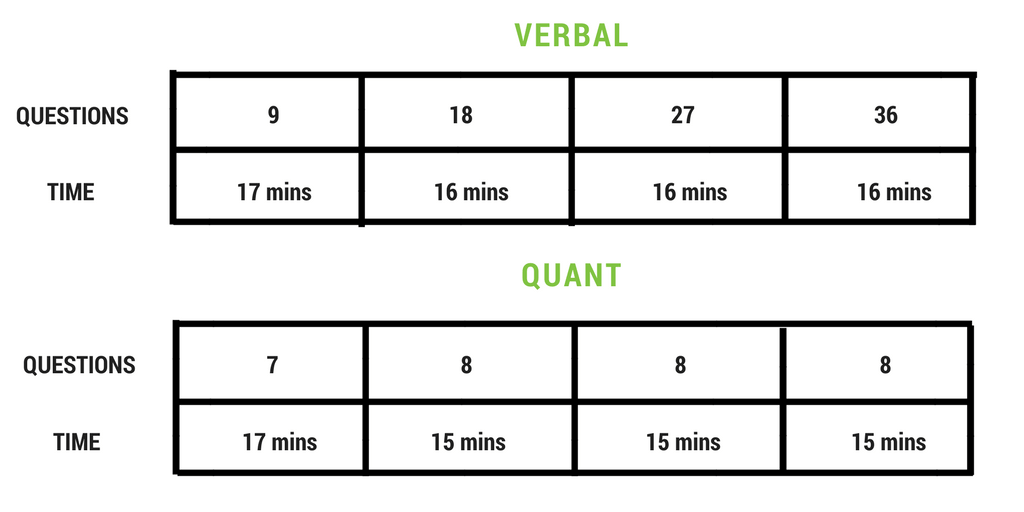How to effectively manage time on the GMAT?
On the GMAT, you are bombarded with 36 Verbal and 31 Quant questions to be finished in 62 minutes & 65 minutes respectively! Suddenly you will realize that these 127 minutes are the shortest of all the 127 minutes you ever experienced!
Let us look at it from a mathematical angle.
The usual gyaan that every potential test taker receives from everyone: ‘Solve each verbal question in 1.5 minutes and quant in 2 minutes in order to prevent running out of time, because on the GMAT, leaving questions unanswered in even worse than getting a few of them wrong!’
NOTE: We have updated this blog based on the announcement by GMAC on some major changes in the GMAT test timing and the number of questions you’re going to be having in both Quant and Verbal.The new GMAT exam will be shorter by 30 minutes from April 16th, 2018.
Let us do some math on the time you have on the GMAT to answer the Quantitative and Verbal sections:
62 minutes means 3,720 seconds for the quant section.
65 minutes means 3,900 seconds for the verbal section.
31 questions in Quant means 120s per math question.
36 questions in Verbal means 108.33s per verbal question.
What if I told you that you have to come as close to the 120/108.33 mark as possible for you to do well? Sounds a bit stupid right? I mean how do you guarantee you are going to be able to solve a question in precisely the time allotted?
After all, this is not making widgets in a factory assembly line. You will argue that you need to alter your approach on each question and it could take more or less depending on various factors (position of the question, mental fatigue, difficulty of the question, your comfort with the topic tested etc).
So now you would rather have a “range” of time within which you will work.
Agreed!
So what is that range?
Can we assume 100 to 140 seconds for a quant questions and 100 to 120 seconds for a verbal question?
What if you are able to solve a straight-forward SC question in 50 seconds?
Or say you have a tough CR boldface that requires 3 minutes? What would you do?
Can we make the range 40s to 180s?
Does it mean you now cannot solve the question in 39s?
Or give yourself 181s?
As you will realize this argument can keep going on…There is no perfect answer to this question.
What is important is that you give merit to each question and answer it in whatever time that it takes you to solve it.
However the bad news is that
The test also imposes constraints on you. You don’t want to end up in a situation where you spent way too much time on many questions and eventually ran out of time.
However, will it be possible for you to check after every 2 minutes how many questions you were able to finish or after every question, check how much time was spent on it?
It is like eating custard apple and spending a good amount of time in picking up each of its seeds and counting on how many are left? This approach will instead increase the anxiety of the test takers and affect the concentration, thereby affecting his performance on the wrong side of the scale.
So, is there a better approach? What about a muskmelon that can be easily divided into big 5-6 wedges?
What is the time strategy that we prescribe?
Well for Quant, instead if trying to manage the whole 62 minutes,
Try to break it into 4 parts:
So allocate 17 minutes for the first part and the subsequent 15 minutes each for the next 3 parts.
So basically you should be looking at solving 7 questions in the first 17 minutes and solve 8 questions each in the subsequent 15 minutes chunk.
Now for verbal, they way we suggest you split is 17 minutes for the first quarter, 16 minutes for the second, 16 minutes for the third and 16 minutes for the fourth
In the each of these quarters we recommend you solve at least nine questions each.
So 9 +9 + 9 + 9 = 36 questions & you are done with Verbal.

If you see the strategy is based on you spending slightly more time in the first quarter. Just because we feel that when you’re starting your test – there is going to be a little bit of inertia.
This strategy will give you that extra one or two minutes initially as opposed to the second, third and fourth quarter.
Now you can choose the order in which you want to take up the sections before starting the test. This is a recent change to the GMAT test structure. It was introduced in July 2017. We have done a detailed analysis of what this means to an Indian GMAT test-taker in the this blog
GMAT Section Selection – Everything you need to know
Try out this strategy and let us know if it works. Please post your comments on what strategy *you* use to manage your time!
Hope these techniques make a positive difference to your GMAT prep! If you’d like to share what works for you and what doesn’t, please leave a comment in the comment section below.
If you are looking for more customized and focused prep, why don’t you check out our GMAT courses!

